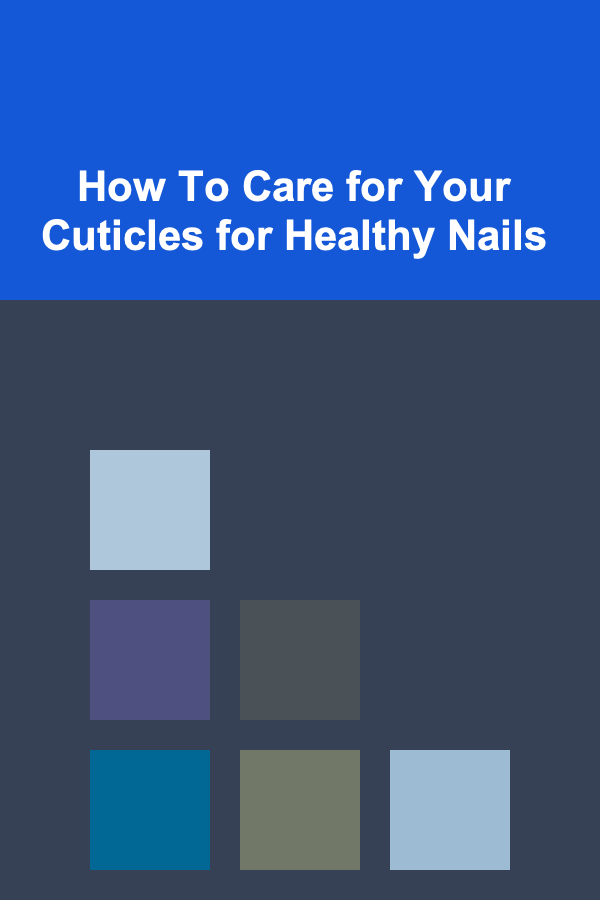
How To Care for Your Cuticles for Healthy Nails
ebook include PDF & Audio bundle (Micro Guide)
$12.99$11.99
Limited Time Offer! Order within the next:

Understanding the Importance of Cuticles
Cuticles, often overlooked in our nail care routines, play a crucial role in protecting our nails and maintaining their overall health. Understanding their function is the first step towards proper cuticle care. The cuticle is the thin layer of skin that grows from the base of the nail onto the nail plate. Its primary function is to act as a protective barrier, sealing the space between the nail plate and the skin of the finger or toe. This seal prevents bacteria, fungi, and other harmful pathogens from entering and causing infections, which can significantly damage the nail matrix and lead to nail deformities or even systemic illness.
Think of the cuticle as a gatekeeper for your nail bed. A healthy, intact cuticle prevents invaders from reaching the vulnerable area where new nail cells are formed (the nail matrix). Damage to the cuticle compromises this protective barrier, leaving your nails susceptible to infections like paronychia (a bacterial or fungal infection of the skin around the nail) and other nail problems. In addition to preventing infections, healthy cuticles also contribute to a smoother, more even nail growth. When the cuticle is dry, cracked, or damaged, it can hinder the growth process, leading to ridges, unevenness, and a generally unhealthy appearance.
Therefore, caring for your cuticles is not just about aesthetics; it's about maintaining the health and integrity of your nails. Neglecting your cuticles can lead to a cascade of problems, including painful infections, unsightly nail deformities, and overall weakening of the nails. By understanding the importance of cuticles and implementing a proper care routine, you can significantly improve the health and appearance of your nails.
Common Cuticle Problems and Their Causes
While a healthy cuticle is a boon for nail health, several common problems can affect them, leading to discomfort and potential complications. Understanding the causes behind these issues is crucial for effective prevention and treatment.
Dryness and Cracking
One of the most frequent cuticle complaints is dryness, which often manifests as cracked, peeling, or even bleeding cuticles. Several factors can contribute to this issue:
- Environmental Factors: Exposure to harsh weather conditions, such as cold, dry air or excessive sunlight, can strip the cuticles of their natural moisture, leading to dryness and cracking.
- Frequent Hand Washing: While hand washing is essential for hygiene, excessive washing, especially with harsh soaps, can remove the natural oils from the skin and cuticles, resulting in dryness. Alcohol-based hand sanitizers can also exacerbate this problem.
- Exposure to Chemicals: Cleaning products, detergents, and other household chemicals often contain harsh ingredients that can irritate and dry out the cuticles.
- Dehydration: Insufficient water intake can affect the overall hydration of the body, including the skin and cuticles.
- Underlying Skin Conditions: Conditions like eczema or psoriasis can also contribute to dry and inflamed cuticles.
Hangnails
Hangnails are small, torn pieces of skin that detach from the cuticle. They can be painful and, if not properly cared for, can lead to infection.
- Dryness: Similar to dry and cracked cuticles, dryness is a primary cause of hangnails. When the skin around the nail is dry, it's more prone to tearing.
- Picking or Biting: Habitually picking or biting the cuticles is a surefire way to create hangnails. This can damage the skin and create entry points for bacteria.
- Improper Manicuring: Aggressive cutting or pushing back of the cuticles during manicures can also increase the risk of hangnails.
Infections
Compromised cuticles, whether due to dryness, hangnails, or injury, are vulnerable to infections. The most common type of cuticle infection is paronychia.
- Bacterial Infections: Bacteria, often from the hands or mouth, can enter through a break in the skin around the cuticle, causing redness, swelling, pain, and sometimes pus formation.
- Fungal Infections: Fungi can also infect the cuticles, particularly in individuals who frequently have their hands in water or work in humid environments. Fungal infections often present with thickening, discoloration, and separation of the cuticle from the nail.
Inflammation
Inflammation of the cuticles can occur due to various factors, leading to redness, swelling, and tenderness.
- Irritation: Exposure to harsh chemicals, allergens, or even excessive filing or pushing back of the cuticles can cause inflammation.
- Trauma: Accidental injury to the cuticles, such as bumping or snagging them, can also trigger inflammation.
By identifying the underlying causes of these common cuticle problems, you can take proactive steps to prevent them and maintain healthy, resilient cuticles.
Essential Tools for Cuticle Care
Having the right tools can make cuticle care easier, more effective, and safer. Here's a breakdown of essential tools and how to use them properly:
-
Cuticle Pusher: A cuticle pusher, typically made of metal or wood (often orange wood), is used to gently push back the cuticles from the nail plate. Choose a pusher with a rounded, smooth edge to avoid damaging the cuticle.
- Metal Pusher: More durable and easier to sanitize, but requires a lighter touch to avoid injury.
- Wooden Pusher: Gentler but single-use, making it more hygienic.
How to use: After softening the cuticles (see below), gently push back the cuticles in a circular motion. Avoid applying excessive pressure, as this can damage the nail matrix.
-
Cuticle Nippers: Cuticle nippers are small, sharp clippers used to trim hangnails or excess cuticle skin. Invest in high-quality nippers with sharp blades for a clean cut. Dull nippers can tear the skin and increase the risk of infection.
- Jaw Size: Smaller jaws are more precise for trimming small pieces of skin.
- Sharpness: Extremely important. Dull nippers will tear, not cut.
How to use: Only trim loose or detached skin. Never cut the entire cuticle. Use small, controlled snips. Disinfect the nippers after each use.
-
Cuticle Oil: Cuticle oil is a moisturizing product formulated to hydrate and nourish the cuticles. Look for oils containing ingredients like jojoba oil, almond oil, vitamin E, or avocado oil. How to use: Apply cuticle oil to the cuticles and massage it in several times a day, especially after washing your hands or using hand sanitizer.
-
Nail File: A nail file is essential for shaping and smoothing the nails. While not directly for cuticle care, properly filed nails prevent snagging and tearing, which can damage the cuticles.
- Grit: A higher grit (e.g., 240 grit) is finer and gentler, ideal for smoothing the edges of the nails.
- Material: Glass or crystal files are gentler on the nails than emery boards.
-
Small, Sharp Scissors: Can be used very carefully to trim hangnails if nippers are unavailable. Scissors require even more precision to avoid cutting live skin.
Important Considerations:
- Hygiene: Always sanitize your cuticle care tools before and after each use to prevent the spread of bacteria or fungi. Use rubbing alcohol or a disinfectant solution.
- Quality: Invest in high-quality tools that are well-made and durable. Cheap tools are often less effective and can even be harmful.
- Maintenance: Keep your tools clean and sharp. Sharpening your nippers regularly will ensure clean cuts and prevent tearing. Replace tools as needed.
A Step-by-Step Guide to Cuticle Care
Here's a comprehensive step-by-step guide to incorporating cuticle care into your regular nail care routine:
- Soak Your Nails: Soaking your nails in warm, soapy water for 5-10 minutes softens the cuticles and makes them easier to manage. You can add a few drops of cuticle oil or a mild soap to the water.
- Temperature: Warm, not hot. Hot water can dry out the skin.
- Optional Additives: A few drops of essential oil (like lavender or tea tree) can have soothing and antibacterial properties.
- Gently Push Back the Cuticles: After soaking, gently push back the cuticles with a cuticle pusher. Use small, circular motions and avoid applying excessive pressure. Focus on loosening the cuticle from the nail plate, rather than aggressively pushing it back.
- Angle: Hold the pusher at a slight angle.
- Avoid Pressure: The goal is to loosen, not force.
- Trim Hangnails (If Necessary): If you have hangnails, carefully trim them with cuticle nippers. Only trim the loose piece of skin. Avoid cutting into healthy skin, as this can lead to infection.
- Only Trim Loose Skin: Do not attempt to cut the entire cuticle.
- Small Snips: Use small, controlled snips to avoid injury.
- Apply Cuticle Oil: Apply cuticle oil to the cuticles and massage it in thoroughly. This will help to hydrate and nourish the cuticles, keeping them soft and supple.
- Massage: Massage helps the oil penetrate the skin and stimulates blood flow.
- Frequency: Apply several times a day, especially after washing hands.
- Moisturize Your Hands: Follow up with a good quality hand cream to moisturize the entire hand, including the cuticles.
- Ingredients: Look for hand creams containing ingredients like shea butter, glycerin, or hyaluronic acid.
- Application: Apply after washing your hands and before going to bed.
- Optional: Gently Exfoliate: A very gentle exfoliation using a sugar scrub or similar product can help remove dead skin cells, but must be done with extreme care. Over-exfoliation can be very damaging.
Dos and Don'ts of Cuticle Care
To ensure you're caring for your cuticles properly, keep these dos and don'ts in mind:
Dos
- Do moisturize your cuticles regularly: This is the most important step in cuticle care. Use cuticle oil and hand cream frequently.
- Do push back your cuticles gently: This helps to keep them tidy and prevents them from adhering to the nail plate.
- Do trim hangnails carefully: Use sharp cuticle nippers and only trim the loose piece of skin.
- Do protect your hands from harsh chemicals: Wear gloves when cleaning or working with chemicals.
- Do stay hydrated: Drinking plenty of water helps to keep your skin and cuticles hydrated.
- Do use sunscreen on your hands: Protect your hands from sun damage, which can dry out the skin and cuticles.
- Do sanitize your tools regularly: Prevents the spread of infection.
Don'ts
- Don't cut your cuticles: Cutting the cuticles removes the protective barrier and increases the risk of infection. Trimming is only for removing hangnails or loose skin.
- Don't pick or bite your cuticles: This can damage the skin and lead to hangnails and infections.
- Don't use harsh chemicals on your hands: These can dry out the skin and cuticles.
- Don't use acetone-based nail polish remover excessively: Acetone is very drying. Choose acetone-free formulas when possible.
- Don't ignore signs of infection: If you notice redness, swelling, pain, or pus, seek medical attention.
- Don't push back cuticles too aggressively: Excessive force can damage the nail matrix.
- Don't use your nails as tools: Avoid using your nails to scrape, peel, or open things, as this can damage the nails and cuticles.
Choosing the Right Cuticle Oil
Cuticle oil is the cornerstone of any good cuticle care routine. But with so many options available, how do you choose the right one? Here's what to look for:
Key Ingredients
The best cuticle oils contain a blend of nourishing and moisturizing ingredients. Look for oils that include:
- Jojoba Oil: Closely resembles the skin's natural sebum, making it easily absorbed and highly moisturizing.
- Almond Oil: Rich in vitamin E and antioxidants, which help to protect and nourish the cuticles.
- Vitamin E Oil: A powerful antioxidant that helps to protect the skin from damage and promotes healing.
- Avocado Oil: Contains essential fatty acids and vitamins that deeply moisturize and nourish the cuticles.
- Apricot Kernel Oil: A lightweight oil that absorbs quickly and helps to soften and smooth the cuticles.
- Coconut Oil: A good source of hydration, but can be comedogenic for some individuals.
- Shea Butter: Provides intense moisture and helps to protect the skin.
- Essential Oils (optional): Some cuticle oils contain essential oils like lavender, tea tree, or lemon, which can provide additional benefits such as soothing, antibacterial, or antifungal properties.
Formula
Cuticle oils come in various forms, including:
- Oils: The most common type of cuticle oil. They are typically applied with a dropper or brush.
- Balms: Thicker than oils and provide a more intense moisturizing effect.
- Pens: Convenient for on-the-go application.
Scent
While scent is a personal preference, choose a cuticle oil with a scent that you enjoy. Some oils are unscented, while others are scented with essential oils or fragrance. Be mindful of potential allergies or sensitivities to certain scents.
Packaging
Consider the packaging when choosing a cuticle oil. A dropper bottle or brush applicator allows for precise application, while a pen is convenient for carrying in your purse or travel bag.
Price
Cuticle oils range in price from affordable to luxurious. While a higher price doesn't always guarantee better quality, investing in a well-formulated oil with high-quality ingredients is often worth it.
Reading Labels
Always read the ingredient list and look for natural, non-toxic ingredients. Avoid products that contain harsh chemicals or artificial fragrances. Look for terms like "cold-pressed," "organic," or "unrefined," which often indicate a higher quality oil.
Testing
If possible, test a small amount of cuticle oil on your skin before applying it to your cuticles to check for any allergic reactions or sensitivities.
Diet and Hydration for Nail and Cuticle Health
While topical care is essential, the health of your nails and cuticles is also influenced by your diet and hydration levels. Nourishing your body from the inside out can significantly improve the strength and appearance of your nails and cuticles.
Key Nutrients for Nail Health
Several vitamins and minerals play a vital role in nail health:
- Biotin (Vitamin B7): Often touted as the "nail vitamin," biotin helps to strengthen nails and reduce breakage. Good sources of biotin include eggs, nuts, seeds, and sweet potatoes.
- Iron: Iron deficiency can lead to brittle, spoon-shaped nails. Include iron-rich foods in your diet, such as red meat, spinach, and lentils.
- Zinc: Zinc is essential for cell growth and repair, including the cells that make up your nails. Good sources of zinc include oysters, beef, and pumpkin seeds.
- Vitamin C: Vitamin C is an antioxidant that helps to protect the nails from damage and promotes collagen production, which is essential for nail strength. Good sources of vitamin C include citrus fruits, berries, and bell peppers.
- Omega-3 Fatty Acids: Omega-3 fatty acids help to moisturize the nails and keep them strong. Good sources of omega-3 fatty acids include fatty fish, flaxseeds, and walnuts.
- Protein: Nails are made of keratin, a protein. Ensure adequate protein intake to support nail growth and strength.
Hydration
Dehydration can lead to dry, brittle nails and cuticles. Drink plenty of water throughout the day to keep your body and nails hydrated. Aim for at least eight glasses of water per day.
Dietary Tips for Healthy Nails and Cuticles
- Eat a balanced diet: Focus on eating a variety of fruits, vegetables, whole grains, lean protein, and healthy fats.
- Include nutrient-rich foods: Prioritize foods that are rich in the key nutrients mentioned above.
- Consider a supplement: If you're concerned that you're not getting enough of certain nutrients through your diet, talk to your doctor about taking a supplement.
- Limit processed foods: Processed foods are often low in nutrients and can contribute to dehydration.
- Avoid excessive alcohol consumption: Alcohol can dehydrate the body and interfere with nutrient absorption.
Foods to Prioritize
- Eggs
- Nuts and Seeds (especially pumpkin seeds, almonds, walnuts)
- Fatty Fish (Salmon, Mackerel)
- Leafy Greens (Spinach, Kale)
- Sweet Potatoes
- Berries
- Citrus Fruits
By focusing on a healthy diet and staying hydrated, you can provide your nails and cuticles with the nutrients they need to stay strong, healthy, and beautiful.
When to See a Doctor
While most cuticle problems can be managed at home, there are times when it's necessary to seek professional medical advice. Here are some signs that you should see a doctor:
- Severe Pain or Swelling: If you experience intense pain or significant swelling around your cuticles, it could be a sign of a more serious infection.
- Pus Formation: Pus indicates a bacterial infection. A doctor can prescribe antibiotics to clear the infection.
- Spreading Redness: If the redness around your cuticles is spreading, it could be a sign of cellulitis, a bacterial infection of the skin and underlying tissues.
- Fever: A fever accompanied by cuticle problems could indicate a systemic infection.
- Nail Deformities: If you notice significant changes in the shape, color, or texture of your nails, such as thickening, discoloration, or separation from the nail bed, it could be a sign of a fungal infection or other underlying condition.
- Chronic Cuticle Problems: If you've tried home remedies and your cuticle problems persist or worsen, see a doctor to rule out any underlying medical conditions.
- Underlying Health Conditions: Individuals with diabetes or compromised immune systems are more susceptible to infections and should seek medical attention sooner rather than later for any nail or cuticle issues.
A dermatologist or your primary care physician can diagnose the underlying cause of your cuticle problems and recommend the appropriate treatment. Don't hesitate to seek professional help if you're concerned about your cuticle health.
Preventive Measures for Long-Term Cuticle Health
While treating existing cuticle problems is important, preventing them in the first place is the best approach for long-term cuticle health. Here are some preventive measures you can take:
- Consistent Moisturizing: Make moisturizing your cuticles a daily habit. Apply cuticle oil and hand cream several times a day, especially after washing your hands.
- Gentle Manicuring Techniques: Avoid aggressive cutting or pushing back of the cuticles. Use gentle, controlled movements and prioritize hydration.
- Protective Gloves: Wear gloves when cleaning, gardening, or working with harsh chemicals.
- Avoid Nail Biting and Cuticle Picking: Break these habits to prevent damage and infections.
- Stay Hydrated: Drink plenty of water to keep your skin and cuticles hydrated.
- Eat a Healthy Diet: Nourish your body with a balanced diet rich in vitamins and minerals.
- Proper Hand Hygiene: Wash your hands frequently with mild soap and water, but avoid excessive washing, which can dry out the skin.
- Avoid Harsh Nail Products: Choose acetone-free nail polish remover and avoid nail polishes that contain harsh chemicals like formaldehyde and toluene.
- Regular Nail Trimming and Filing: Keep your nails trimmed and filed to prevent snags and tears that can damage the cuticles.
- Seasonal Adjustments: Adjust your cuticle care routine based on the season. In the winter, when the air is dry, you may need to moisturize more frequently.
- Professional Manicures (with Caution): If you get professional manicures, ensure that the salon follows proper hygiene practices and uses gentle techniques. Communicate your preferences to the manicurist and let them know if you have any concerns about your cuticle health. Consider bringing your own sanitized tools.
By incorporating these preventive measures into your daily routine, you can maintain healthy, strong, and beautiful cuticles for years to come.

How to Create DIY Crafts for Kids and Parents to Enjoy Together
Read More
How To Understand Global Shipping for Print-on-Demand
Read More
How to Use Mirrors in Home Staging to Create More Light
Read More
How To Understand the Evolution of Esports Sponsorships
Read More
Selecting the Best Bearing Press Set for Bottom Brackets and Hubs
Read More
Identifying Marine Fungi and Protists: A Comprehensive Guide
Read MoreOther Products

How to Create DIY Crafts for Kids and Parents to Enjoy Together
Read More
How To Understand Global Shipping for Print-on-Demand
Read More
How to Use Mirrors in Home Staging to Create More Light
Read More
How To Understand the Evolution of Esports Sponsorships
Read More
Selecting the Best Bearing Press Set for Bottom Brackets and Hubs
Read More